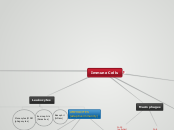by Ravi Chacko 8 years ago
2092
Immunology

by Ravi Chacko 8 years ago
2092

More like this
After a B cell with antigen is initially activated by at Th cell
Affinity Maturation happens in germinal center - B cell is activated by Th2, starts rapidly reproducing and mutating (regulated by Th2). The one with the highest affinity reproduces - some become plasma.
1) IgM released by B cells to make immune complexes
2) Dentric cells pick up complexes and bring to follicle to allow affinity maturation of B cells
3) If B cell has high affinity to an antigen and gets costimulation by Th2 then it starts to proliferate
Poison Ivy
T Cell (AIRE)
CD4+ (Th0) APC: CD4/CD3 binding
no CD28 ANERGY
Parasite/Allergen IL-4 / STAT6
Th2
Unknown mechanism -
IL-4 is released in response to parasite that stimulates
IL-13
TGFB
IL-4
IL-5
IL-10
Bact/Virus phag by proAPC, which makes IFNg and IL12, which binds to STAT4 on Th0
Th1
Simultaneously produces IFNg while downregulating the receptor - so that IFNg only inhibits Th2
Subtopic
Cytokines
IFNg
Inhibits growth when bound to receptor
GM-CSF
IL2
TNFa
CD8+
Cytotoxic T cell + Macrophages
Plasma B Cell
IgE
IgG
Immunoglobulin
A: Mucosal immunity (passive)
E: Mast Degranulation - hypersensitivity
G: Opsinization, complement, passive immunity
M: Complement activation
VDJ recomb
AID1
Rag